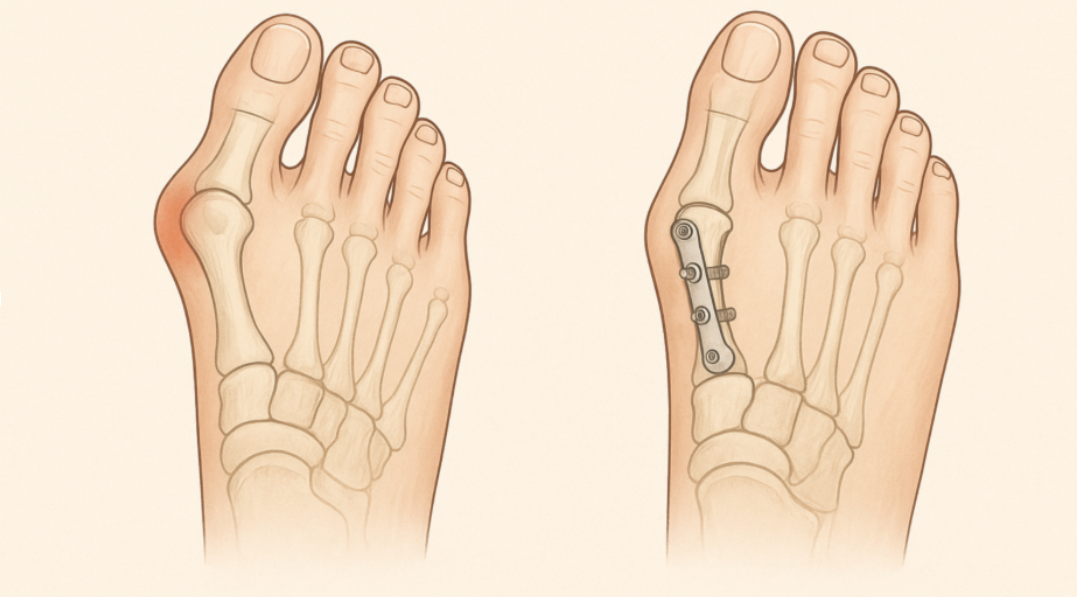New Bunion Surgery Techniques: What to Know About Lapiplasty and Modern Procedures
November 17, 2025

Bunion treatment has come a long way. Years ago, most surgeries focused only on shaving down the bump or shifting the bone slightly. Today, new bunion surgery techniques aim to correct the true source of the deformity: joint instability and 3D bone misalignment. This means better alignment, improved comfort, and in many cases, a smoother recovery.
If you’ve been living with bunion pain or wondering whether there is a new surgical procedure for bunions that fits your lifestyle, this guide explains what’s changed, how modern techniques like Lapiplasty® work, and what recovery really looks like.
Why Bunion Surgery Has Evolved
Traditional bunion surgery focused on reducing the visible bump. While effective for many patients, it didn’t always address the underlying rotation or instability of the first metatarsal bone. As a result, some patients experienced recurrence over time.
Today’s new bunion surgery techniques are more advanced. Instead of simply removing bone, they are designed to:
- Correct the bunion in three dimensions
- Stabilize the joint at the base of the big toe
- Reduce the chances of the deformity returning
- Support earlier walking and a more predictable recovery
This shift has led to several advanced options, including minimally invasive procedures, Pecaplasty, and the highly standardized new operation for bunions known as Lapiplasty.
If you’re beginning to explore treatment or want a clearer understanding of your options, you can learn more about bunion symptoms and care on our Bunions page.
Understanding Lapiplasty®: A Modern 3D Approach
Lapiplasty® is one of the most innovative new bunion surgery techniques available today. Unlike older methods that mainly shaved down the bump, this new surgical procedure for bunions corrects the bunion at its source: the unstable, rotated position of the first metatarsal bone. Many people mistakenly refer to it as “Lapiplasty surgery,” but the accurate term is Lapiplasty.
How Lapiplasty Works
Lapiplasty gently rotates the bone back into its natural 3D alignment and stabilizes the joint using low-profile titanium plates. By correcting the underlying deformity rather than the surface appearance, this new operation for bunions aims to deliver longer-lasting results and a lower chance of recurrence.
Lapiplasty Bunion Surgery Recovery Time
One of the key advantages of Lapiplasty is its recovery timeline. Typical lapiplasty bunion surgery recovery time allows for protected walking in a boot within a few days, with steady progress over the next several weeks. Most patients transition into supportive shoes around 6–8 weeks, and final healing continues as swelling settles. When reviewing common bunion before and after surgery expectations, patients often see straighter alignment, reduced joint pressure, and improved shoe comfort as healing progresses.

Minimally Invasive Bunion Procedures
Not every patient needs a larger incision or 3D realignment. Some benefit from minimally invasive (MIS) techniques, which use very small incisions and specialized instruments to realign the bone.
Benefits include:
- Smaller scars
- Less soft-tissue disruption
- Reduced swelling for some patients
- Faster return to daily movement
MIS procedures are another type of new operation for bunions, but they are most appropriate for certain bunion shapes and severities. Severe deformities or arthritis may still require more advanced stabilization.
Pecaplasty vs. Lapiplasty: How They Compare
Many patients research Pecaplasty vs Lapiplasty to understand which option fits their needs. Both are modern techniques, but they work differently.
Pecaplasty
- Usually minimally invasive
- Realigns the metatarsal through small incisions
- Often used for moderate bunions
- Short recovery period in many cases
Lapiplasty
- Corrects deformity in all three dimensions
- Stabilizes the unstable joint at the root of the bunion
- Ideal for moderate to severe cases or recurrent bunions
- Offers strong long-term stability
The best technique depends on anatomy, severity, lifestyle, and long-term goals.
When a New Bunion Surgery Technique May Be Right for You
Modern procedures may be the right choice when:
- Bunion pain interferes with daily activities
- The big toe continues to drift or overlap
- Comfort shoes no longer relieve pressure
- Conservative care no longer helps
- You want a procedure that corrects the root cause
- You’ve had previous bunion surgery and symptoms have returned
A foot and ankle specialist can evaluate your bone structure, review imaging, and determine whether a new bunion surgery such as Lapiplasty, Pecaplasty, or a minimally invasive approach is the safest and most effective option for you.
Realistic Results: What to Expect After Surgery
Every patient wants to know what their foot will look and feel like once healing is complete. While results vary by procedure and bunion severity, most people experience meaningful improvements once swelling subsides and the bone fully heals. When reviewing common bunion before and after surgery outcomes, several changes stand out:
- The big toe sits in a straighter, more natural position
- Pressure on the bunion joint decreases, reducing irritation
- Shoe comfort improves as the foot no longer rubs against the inside of footwear
- Stability increases, particularly with procedures that correct underlying joint instability like Lapiplasty
These changes develop gradually over the healing period, with final results becoming clearer as mobility returns and inflammation settles.
Finding the Right Modern Option for Your Feet
Today’s new bunion surgery techniques offer more precise correction and improved stability than ever before. Whether it’s Lapiplasty, Pecaplasty, or a minimally invasive approach, the best procedure is the one tailored to your foot structure and long-term goals.
If you’re ready to explore your options, Foot & Ankle Specialists of Utah is here to help. Book your appointment today find the right path toward lasting comfort and confident movement.
Schedule an Appointment Today!
If any of these signs or symptoms sound familiar to you, don’t wait! Schedule an appointment with one of our specialists TODAY and get back to living your best life! For more tips, tricks, and helpful information, be sure to check out our social media accounts!